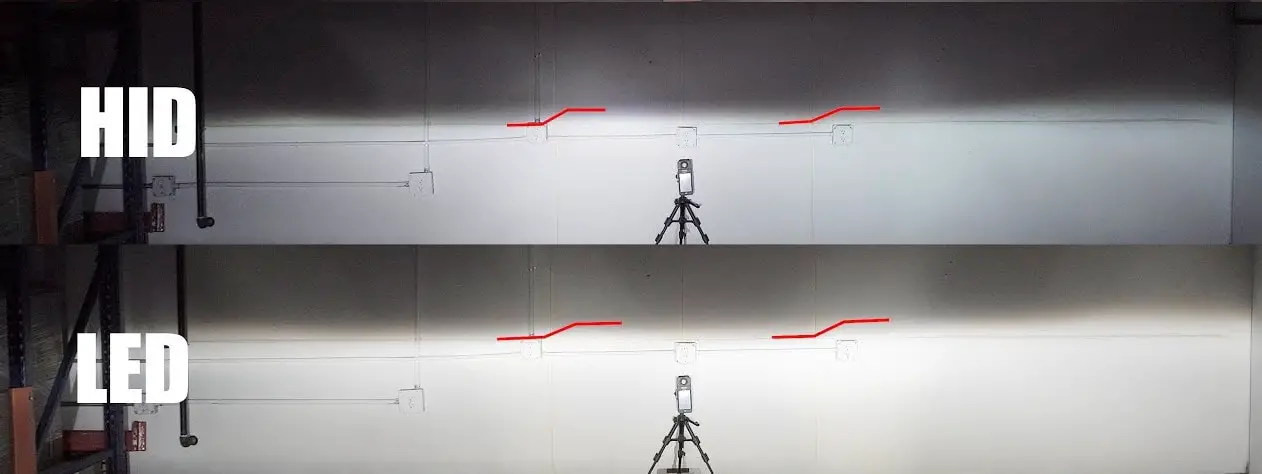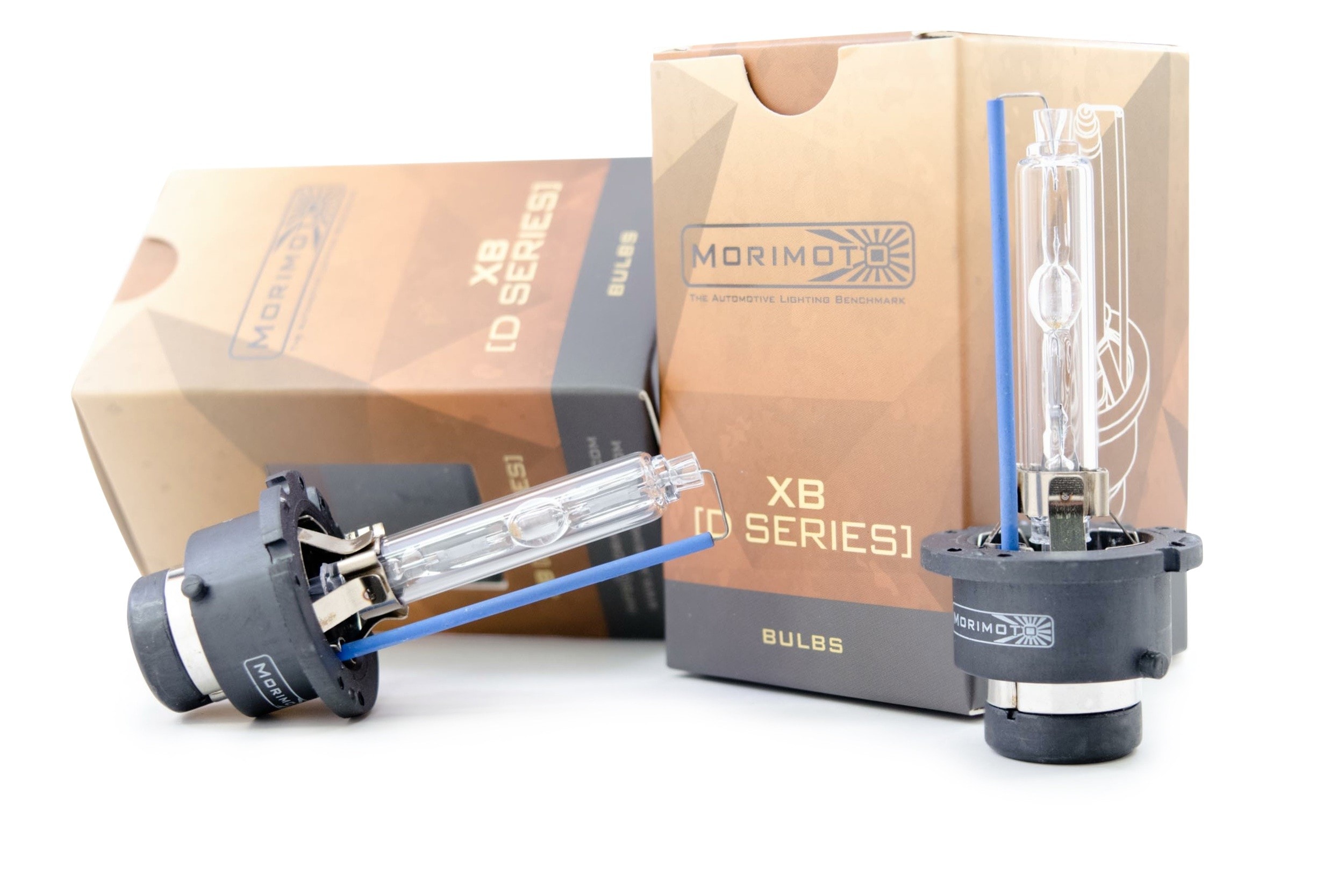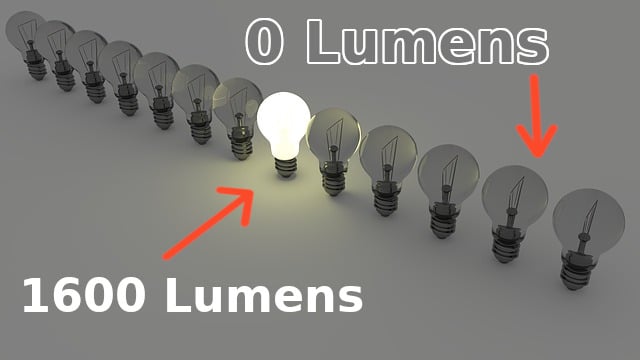Is this a trick question? Hopefully not. The answer to which is brighter between HID vs LED headlights will depend on the type of LED bulb… and of course the type of HID bulb… and the Headlight Housing!
Lumens and Kelvin rating also play a factor! Most aftermarket LED headlight bulbs will be just as bright as a set of HID bulbs.
Both sets can push over 12,000 Lumens of brightness onto the road which is overkill for most people (and dangerous for oncoming drivers).
But in order to understand this concept fully, let’s first look at the pros and cons to LEDs and HIDs, and then we’ll discuss the lumens rating (brightness) of each bulb.

HID vs LED Headlights – Compared side by side
LED
- LEDs emit less heat and are more efficient
- LEDs are directional by nature and can focus more light over a given target area
- Longer lifespan
- Lesser maintenance required
- LED headlights are more expensive than HID
- Heat can fry the circuit board if the kit isn’t vented correctly
HID
- Intense and bright light
- Lower cost
- Easier to retrofit to older cars
- HID bulbs must warm up before producing the brightest possible light
- HIDs need ballasts and starters to operate, which are also bound to fail at some point
- HIDs produce more glare due to the omnidirectional light projection
- Shorter lifespan compared to LED bulbs

LED Headlights
In theory, LED headlights are brighter than HID headlights.
It all has something to do with system efficiency or the amount of light that actually hits the target area. In this case, we’re talking about how bright LED bulbs can illuminate the road as you drive. We already know LED lights are efficient when measuring the lumens per watt output or the source efficiency. But what’s interesting is the system efficiency.
Standard HID bulbs struggle to achieve close to 25-percent of source efficiency. Yet, LED headlights are capable of achieving 50-percent source efficiency. This means more light emits and reaches the road per watt of power consumed.
What are LEDs
LEDs or Light-Emitting Diodes are electrical components with two electrodes:
- Anode
- Cathode
Electricity flows one way inside the anode through the cathode. Both diodes are constructed from semiconductor materials. When the current flows between the diodes, the movement of electrons generates light, hence the term ‘light-emitting diode’.
The principle of escaping light particles as electrons move through a semiconductor is also called electroluminescence.

LED Advantages Over HIDs
In our opinion, LED has many advantages over conventional HID lighting systems.
First is the lifespan. LED bulbs are capable of lasting 20-50,000+ hours or more compared to HID which only lasts around 3-8,000 hours on average before losing intensity. On the other hand, even conventional LED bulbs are capable of lasting up to 25-percent longer than HID bulbs.
And there’s a reason why LEDs are the most energy-efficient among HID bulbs and traditional halogen lights.
LED bulbs emitting light in a directional manner means fewer losses of light intensity. Most LED bulbs emit light in a 180-degree arc. Compared this to HID bulbs which are omnidirectional by nature – meaning it emits light in a 360-degree angle – LED headlights need not compensate for losses caused by redirection and reflecting the light output.
Since LED bulbs are more efficient and last longer, this also means fewer maintenance costs over the life of the vehicle. No more fussing about replacing headlight bulbs!

What are the downsides to LED headlight bulbs?
One main concern is the heat in the housing under the LED bulb. We talked a lot more about this in our How long do LED Headlights Last article
Now, the diodes or the bulbs are not the problem. LED headlight bulbs produce less heat in the same way that HID bulbs are cooler compared to halogen bulbs.
But the circuits and electrical assemblies under the LED bulb are subjected to extreme temperatures, which can be hot enough to melt the headlight itself. That’s why LED bulbs will come equipped with heat sinks or fans to vent out the heat from the electrical circuitry. You won’t have this type of issue with HID headlights.

HID Headlights
Before HID became standard in modern cars, the average driver had to make do with halogen lights. Even though halogen bulbs are the cheapest alternative, most of the light output is accompanied by infrared radiation as heat, which is the reason why halogen headlights are hot to the touch after minutes of operation.
The proliferation of high-intensity discharge HID headlights paved the way for brighter and more efficient lighting. Although HIDs also emit infrared radiation in the form of heat, most of the radiation is in the visible light spectrum, which means better efficiency and a higher-quality light.
What are HIDs
High-intensity discharge is a type of gas discharge light and is among the oldest types of electrical light. A typical HID bulb houses a pair of tungsten electrical conductors or electrodes within an ionized gas chamber containing Xenon gas or plasma.
When electrical current passes between the two electrodes inside the HID bulb, the electrical arc begins to excite or evaporate the gas inside the chamber, which produces intense light in the process. HID bulbs need a short warm-up period to produce the brightest possible light output. Keep in mind the intensity, brightness, and color temperature of HID bulbs are dependent on a variety of factors, although most of it has something to do with the amount of Xenon gas evaporating into plasma as the bulbs turn ON.

HID Advantages Over LEDs
The primary advantage of HID over LED bulbs is the cost.
True to form, HID headlights are more affordable than a comparable LED bulb, and this holds true despite the prerequisite ballasts and starters that accompany a high-quality HID lighting kit. Yet, LEDs are catching up by lowering prices.
Second, retrofitting an HID into an older car that uses Halogens is much simpler. You don’t usually have to mess with changing out expensive headlight housing or anything. Just plug in the new HID ballast kit and you’re off!
We also like how HID bulbs are capable of producing the whitest possible light. And while this may be illegal in many countries, HID bulbs are available in a wider variety of color spectrums from yellow and white to bluish-white all the way to green and purple. You can’t have that option in a halogen bulb, although LEDs generally have more color options than HIDs.

What are the downsides to LED headlight bulbs?
HID headlights are not as energy-efficient as LED bulbs and as mentioned earlier only reach about 25% of their full efficiency when compared to LEDs. They also crank out a lot of heat!
Another downside to HIDs is lifespan. Their life is a measly 3,000 hours compared to LED’s 50,000 hours.
HIDs also utilize ballasts and starters, which adds more complicated parts and points of failure.
So Which is brighter? HID vs LED Headlights
Realistically speaking, LED bulbs should be brighter, but the technology isn’t quite there yet.
For now, the average HID headlights are brighter in the real world.
The great thing about HID is the ability to select from various color temperatures (Kelvin). If it is legal where you live, you can choose HID headlight bulbs from as low as 3,000K (which is the color of the sun) all the way to 12,000k or higher (which is bluish white to bluish violet).

courtesy of mydepot
You can also choose the color of LED bulbs, but most aftermarket choices offer less color temperature choices (around 4000k to 8000k).
In terms of brightness, LED bulbs have the capability to outshine even the brightest HID headlights…. but you’ll have to wait for a couple more years for the technology to improve.
Which is The Better Choice For You?
We’ve tried both in our years of driving vehicles. One thing is for sure, both are brighter than the stock halogen headlights!
Here’s what it boils down to:
- People who want to save money, want more color choices, or have older vehicles – HID wins
- People who want longest lasting, highest quality, and have a high budget – LED wins
For most people wanting to upgrade from old Halogens to something brighter, we’d recommend HID since it’s more affordable than LED and it is easier to retrofit in older cars.
Most modern vehicles with LED lighting are designed within the headlight housing since the setup also requires cooling fans to blow heat away from the LED circuit board. It’s a different story when retrofitting aftermarket LED bulbs inside a conventional headlight housing.
But when it comes to pros and cons, LED bulbs have more benefits than drawbacks. And as technology is catching up fast, we can expect prices for LED bulbs to go down along with major improvements in design, cooling, efficiency, brightness, and longevity.

Understanding HID vs LED Headlights Brightness (Lumens) Rating
The lumens or LM is the measured light output of the bulb. Lumens refers to the intensity of a light bulb. It doesn’t have anything to do with the color temperature of the bulb, which is measured via the K or Kelvin rating.
Read more about how many lumens is a car headlight
In order to make it clear, lumens refers to the brightness and intensity of the light. The higher the lumens, the brighter the bulb. So if you compare LED and HID headlight bulbs with the same rating of 4,000 lumens, it simply means both bulbs are about the same in terms of brightness.
But lumens doesn’t refer to the color of the light. In some cases, the color seems to affect the intensity of the light. If you compare two headlight bulbs rated at 700 lumens but with different color temperatures, this means the bulb is only capable of emitting 700 lumens of brightness regardless of the color temperature, whether if the light is yellow or white.
So the next time you browse or look around for a new set of headlight bulbs, the lumens rating will give you an idea on which bulb is brighter than the rest.
What is the Lumens rating of a typical halogen bulb?
Ordinary halogen headlight bulbs are typically rated at around 700 lumens each. But this only applies to the low beam. If you switch into high beam, the bulb is powerful enough to emit approximately 1,200 lumens each. This means you get a total of 1400 lumens at low beam and 2,400 lumens at high beam with both headlights turned on.
Is 700 lumens enough for most driving needs?
Yes, but it will all depend on prevailing weather and road conditions. In some cases, having a more powerful set of headlights will make driving easier, such as when driving in snowy, stormy, or foggy weather.
If this is the case, it is better to upgrade to a set of high-intensity discharge or HID headlights. And while LED presents a ton of benefits, HID is still the preferred upgrade on older model vehicles. This is due to the fact that upgrading from halogen to LED bulbs may require you to change the entire headlight housing assembly. This is not the case for HID kits.
Of course, this will also depend if HID or LED is legal/illegal in your state. In some places HID kits can only be installed if your vehicle is equipped with projector headlights. This is due to the fact that installing HID bulbs in an ordinary reflector headlight may dazzle incoming traffic in the opposite lane.
You also need to consider the amount of space available under the hood. HID headlights will come with a ballast and starter, which will need to be affixed in the engine compartment. However, LED bulbs are simpler and won’t require a separate ballast to operate.
What is the lumens rating of an HID and LED headlight?
Again, the answer will depend on the make or brand of the bulb. In the case of HID headlight bulbs, the typical lumens rating is around 3,000 lumens each for a 35-watt kit. There are HID kits rated at 50-watts and can produce 4,000 to 5,000 lumens each. As you can see, HID headlights are many times brighter than a typical halogen bulb.
Determining the lumens output of an LED headlight is not as easy. Not all LED bulbs are built the same. Some LED headlight bulbs are equipped with up to 16 diodes. If you consider a single 1-watt diode to produce 120 lumens, a single LED bulb with 16 diodes is equivalent to 1,920 lumens, or roughly 3,840 lumens. It will all depend on the amount of diodes in each LED bulb.
You should also be wary of LED bulbs that falsely claim exaggerated lumens outputs. I have seen LED bulbs that claim to produce 10,000 lumens of light, which is silly considering it only had 16 diodes for each bulb. In today’s fast-paced technology, 120 or 130 lumens per diode is the norm. But with further research and development, it won’t be impossible to expect a single diode to produce 200 or more lumens in the very near future.